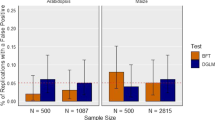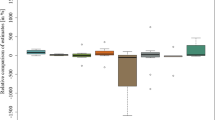Abstract
Phenotypic data for quantitative trait loci (QTL) mapping studies are typically generated at multiple environments in order to broaden the inference space. Many aspects of the usually complex design call for a mixed modelling approach taking into account various sources of variation, e.g., incomplete blocks, a spatial error structure, genetic correlations due to the pedigree, and random environmental effects, including QTL × E interaction. Perhaps the most important source of random variation is the genetic correlation across environment, which arises when the same set of lines is tested in each environment. This correlation is likely to be positive, and ignoring it will lead to an increased rate of false positives. In this paper, we present a mixed modelling framework for QTL mapping based on complex data from multiple environments. Our main focus is on an appropriate modelling for the non-QTL part. The methodology will be illustrated using a barley data set from a BC2F2:5 advanced backcross trial.
Similar content being viewed by others
References
Gilmour, A.R., B.R. Cullis, S.J. Welham & R. Thompson, 1999. ASREML. User manual. ftp://ftp.res.bbsrc.ac.uk/pub/aar/
Jennrich, R.L. & M.D. Schluchter, 1986. Unbalanced repeated measures models with structured covariance matrices. Biometrics 42: 805–820.
Kenward, M.G. & J.H. Roger, 1997. Small sample inference for fixed effects from restricted maximum likelihood. Biometrics 53: 983–997.
Malesotti, M., J. Voltas, I. Romagosa, S.E. Ullrich & F.A. van Eeuwijk, 2004. Mixed models including environmental variables for studying QTL by environment interaction. Euphytica (this volume).
Piepho, H.P., 1997. Analyzing genotype-environment data by mixed models with multiplicative effects. Biometrics 53: 761–766.
Piepho, H.P., 2000. Amixed model approach to mapping quantitative trait loci in barley on the basis of multiple environment data. Genetics 156: 253–260.
Pillen K., A. Zacharias & J. Léon, 2003. Advanced backcross QTL analysis in barley (Hordeum vulgare L.). Theor and Appl Genet 107: 340–352.
Searle, S.R., G. Casella & C.E. McCulloch, 1992. Variance Components. Wiley, New York.
Wolfinger, R.D., 1996. Heterogeneous variance–covariance structures for repeated measures. J Agr Biol Environ Stat 1: 205–230.
Author information
Authors and Affiliations
Rights and permissions
About this article
Cite this article
Piepho, HP., Pillen, K. Mixed modelling for QTL × environment interaction analysis. Euphytica 137, 147–153 (2004). https://doi.org/10.1023/B:EUPH.0000040512.84025.16
Issue Date:
DOI: https://doi.org/10.1023/B:EUPH.0000040512.84025.16




